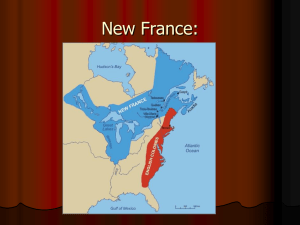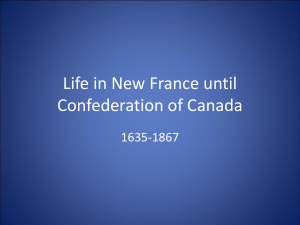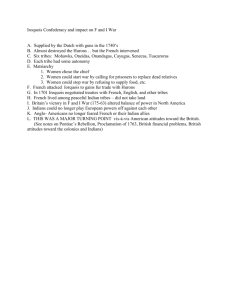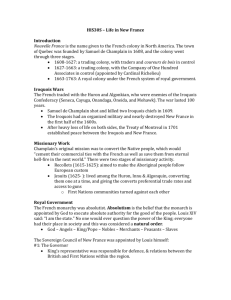Chapter 8 Notes
advertisement
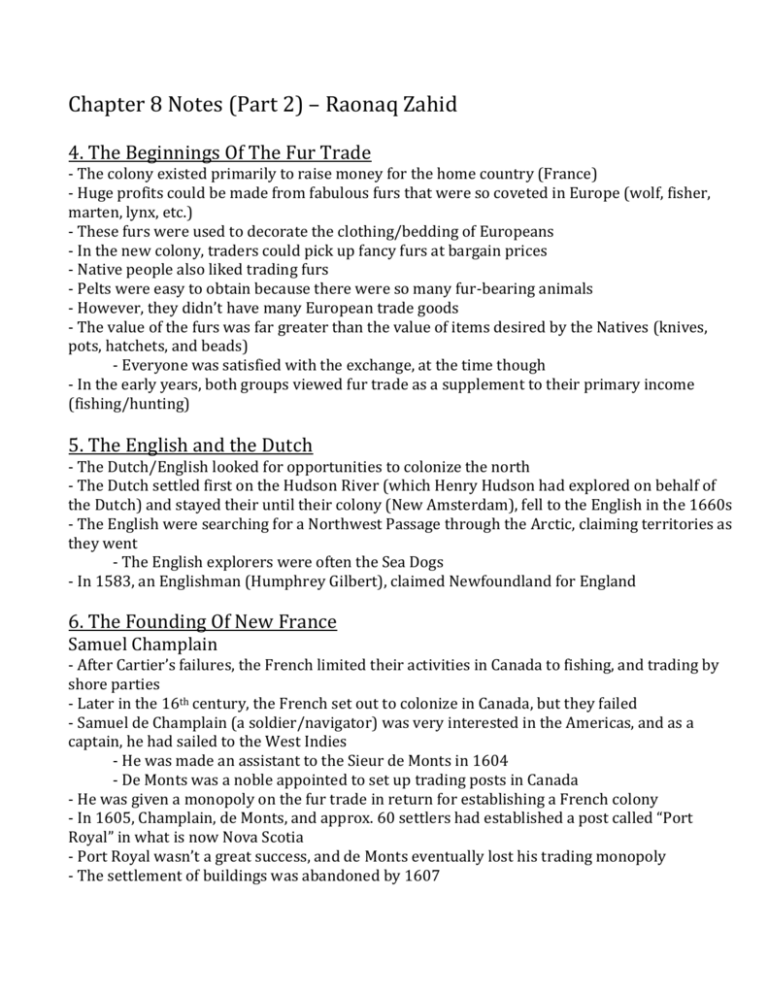
Chapter 8 Notes (Part 2) – Raonaq Zahid 4. The Beginnings Of The Fur Trade - The colony existed primarily to raise money for the home country (France) - Huge profits could be made from fabulous furs that were so coveted in Europe (wolf, fisher, marten, lynx, etc.) - These furs were used to decorate the clothing/bedding of Europeans - In the new colony, traders could pick up fancy furs at bargain prices - Native people also liked trading furs - Pelts were easy to obtain because there were so many fur-bearing animals - However, they didn’t have many European trade goods - The value of the furs was far greater than the value of items desired by the Natives (knives, pots, hatchets, and beads) - Everyone was satisfied with the exchange, at the time though - In the early years, both groups viewed fur trade as a supplement to their primary income (fishing/hunting) 5. The English and the Dutch - The Dutch/English looked for opportunities to colonize the north - The Dutch settled first on the Hudson River (which Henry Hudson had explored on behalf of the Dutch) and stayed their until their colony (New Amsterdam), fell to the English in the 1660s - The English were searching for a Northwest Passage through the Arctic, claiming territories as they went - The English explorers were often the Sea Dogs - In 1583, an Englishman (Humphrey Gilbert), claimed Newfoundland for England 6. The Founding Of New France Samuel Champlain - After Cartier’s failures, the French limited their activities in Canada to fishing, and trading by shore parties - Later in the 16th century, the French set out to colonize in Canada, but they failed - Samuel de Champlain (a soldier/navigator) was very interested in the Americas, and as a captain, he had sailed to the West Indies - He was made an assistant to the Sieur de Monts in 1604 - De Monts was a noble appointed to set up trading posts in Canada - He was given a monopoly on the fur trade in return for establishing a French colony - In 1605, Champlain, de Monts, and approx. 60 settlers had established a post called “Port Royal” in what is now Nova Scotia - Port Royal wasn’t a great success, and de Monts eventually lost his trading monopoly - The settlement of buildings was abandoned by 1607 - A few settlers were allowed to stay, become highly skilled farmers, and end up forming the colony of Acadia - In 1608, Champlain led an expedition up the St. Lawrence - He found no evidence of the village of Stadacona, but he did meet the Native hunters from the northern forests (Algonkians/Montagnais) - Champlain established a post at Quebec and allied with the Algonkians/Montagnais against the Iroquois - Champlain helped the Algonkians win several battles against the Iroquois 7. An Alliance with the Huron Empire - Hurons were closely related to the Iroquois, but had become their enemies - The Hurons navigated the rivers of central Canada and were very prosperous - Champlain was eager to form an alliance with them - They would go on to become the leading source of furs for the French - Hurons had many economic advantages because of their geographic location - Fishing was excellent in their region, and the vegetation of the region included mixed forests, meadows, and fields - They lived in communities of 800-1600 people, and their total population numbered some 20,000 - Their longhouses were designed to house many families and were surrounded by palisades and huge fields - The Hurons were primarily farmers who lived on their produce - They didn’t hunt much, and meat made up less than 10% of their diet - Economy was based on farming, which was directed by women - Every spring, the women would plant enough corn for several years - Corn would be traded to the tribes who lived north of the Canadian Shield - The Algonkians/Nipissings were eager to trade their furs for corn - Women also collected hemp (tall herb), which was used for fishing nets - Fishing nets were always in demand for trading - The Algonkians/Montagnais were uneasy about Champlain forging links with the Huron nation - Champlain made many trips back/forth between Canada/France, looking for money to back his ventures - Hats made from beaver fur were becoming popular in Europe and North America seemed like a place where money could be made - In 1613, Champlain became a partner in a trading company with a monopoly in Canada, and by 1616, his partners (the Hurons) were supplying most beaver furs along the St. Lawrence - Champlain started sending out “coureurs de bois” (young men) to explore the Great Lakes region - These men were to live with Native peoples and marry into their communities - They travelled far into the interior of the country, guided to the great lakes by Huron allies Chapter 8 Notes (Part 3) - In 1615, Champlain and Etienne Brule accepted an invitation from the Hurons to visit them in their own land - In Quebec, Champlain struggled to keep his venture going, as the company was making good money, but France had no interest in building a settlement - Some Native allies started to become annoyed with Champlain - When the English Kirke brothers attacked Champlain’s colony, the Algonkians guided the English, and refused to help the French - Champlain was captured and taken prisoner - The Algonkians/Montagnais turned on the French because they were uneasy about Champlain forging links with the Huron nation - However, Champlain’s colonies didn’t die and a new company (The Company of a Hundred Associates), took over - They were backed by the most powerful person in France, Cardinal Richelieu - Champlain returned to Quebec in his sixties, and began to rebuild the colony - He set up posts in Company’s name at different places along the river - Champlain died on Christmas Day, a few years later 8. Settlement and Colonization - European countries were working hard to extend their imperial interests around the world - The Dutch/English had colonies on the East Coast and had possession of islands in the Caribbean - The English’s “Thirteen Colonies” (Massachusetts, Maryland, Connecticut, Rhode Island, Delaware, Virginia, New Jersey, Maine, and Carolina) were growing rapidly - The Company of a Hundred Associates was required to bring settlers to Canada and establish seigneuries - The Company viewed the settlement issue with reluctance - In the long run, the Company was a business failure - They lost its monopoly in the fur trade in 1660 and soon became bankrupt 9. The Jesuit Missions - The Jesuits (an order of Roman Catholic priests) were partners of the Company - Richeliu wanted the Native peoples to convert to Catholicism - Other missionaries had tried/failed to convert the Hurons, but the Jesuits were willing to do anything to spread the influence of the Church - They were also prepared to adapt to Native traditions/customs - This allowed them to co-exist with the Hurons - The Hurons were still unwilling to abandon their culture/religion - The Jesuits found that learning the Native Languages was hard - The Native languages ranged from French to Latin, and they included many connected words - The meaning of something depends on where the speaker was - Hurons who converted enjoyed privileges in the fur trade, so many joined the Church - Some Hurons still refused to join Church, and this disagreement split the Huron nation 10. The Role of the Coureurs De Bois - The French tried to keep close trading relationships with Native peoples and they wanted them to come to St. Lawrence - The coureurs de bois were the independent traders of the fur business - They had to go to the source, since the Iroquois stopped other Native bands from bringing furs to the St. Lawrence - They bribed the officials to look away - The young men travelled the waterways in birch-bark canoes - This started the fur brigades, which would open up the west to the fur trade - Pierre Radisson and Médart de Groseilliers are the most famous of the coureurs de bois - Médart brought many furs from the North Country - Pierre was guided to Hudson Bay and the rich fur territories that surrounded it - When both failed to interest France, they went to England, where Charles II started the Hudson’s Bay Company aka HBC (soon to be New France’s #1 enemy) 11. The Royal Province of New France - In 1635, only a few French lived in New France, because the Company failed to bring settlers to Canada, and the Iroquois controlled the fur trade - However, in 1661, France (led by Louis XIV) was determined to make New France strong and profitable - The theory of mercantilism was very popular in the 17th century - To Louis and Colbert, Canada needed to be a part of the French mercantile empire - Wood was cheaper in Canada than anywhere else - Louis knew that they had to organize life in New France so it could operate successfully - France sent 1100 soldiers to New France, almost doubling the population of Canada - They attacked/burned Iroquois villages until the Iroquois asked for peace - Both sides got what they wanted: the French could open up the fur trade on the west, and the Iroquois could focus on expanding their territory elsewhere - In 1663, New France was made a royal colony - A governor was appointed to rep the King of France, establish treaties with the Natives, and supervise defense - A chief admin (intendant) would govern the local people, and soldiers would provide protection - A Catholic bishop would handle religious affairs, and priests/nuns would convert the Natives to Christianity - Together, they formed the Sovereign Council - France wanted New France to be a small copy of the home country Chapter 8 Notes (Part 4) - It had the same seigneurial system as France 12. The First Government - Jean Talon was New France’s first intendant, and he knew what New France needed - The arrival of the soldiers made the royal colony safer, and increased its population - Talon recruited women (often orphans) who had the least to gain by staying in France - These women were known as the ‘filles du roi’ or ‘the king’s daughters’ - Over the next 10 years, hundreds of young women came to start new lives in Canada - Talon established a lumber mills, brewery/tannery, and built small ships in Canada - These made trade within the empire easier, and life in the colony more comfortable - These made New France stronger, more profitable to France, and more self-sufficient - Frontenac was New France’s first governor - He agreed to take the job, because he needed to escape from people he owed money to - Frontenac fought with the Church and the government from the beginning - He extended the boundaries of the empire (against Louis’ orders) by sending the coureurs de bois to look for more fur - He also disliked the Jesuits, who harmed the fur trade - Frontenac tried to build an alliance with the Iroquois at one point, while building forts to protect against their attacks - The Iroquois would only agree if the French wouldn’t expand their territory - Frontenac was recalled to France in 1682 13. Life in New France - Life was anchored in the seigneurial system - Seigneurs/lords were granted parcels of land, and habitants/peasant farmers had the right to cultivates the land in exchange for fees/services to the seigneur - Seigneurs/habitants were prosperous, and many worked part-time - The people of New France had an attitude of independence - This irritated reps of France, who thought that colonists had forgotten their place 14. The Seigneury - By 1663, there were 104 seigneuries divided into more than 13 million square arpents - A seigneur had to build/live in a manor house, hold court in the event of disputes, attract settlers, build a mill, and he was responsible for defense - Habitants had to pay rent, provide days of service to the seigneur, and serve in the militia 15. The Habitants - Their lives were built around the manor/Church - Younger people worked in the fur trade, or in the small industries of Quebec - Women worked on the farm, had plenty of children, and lived simply - Life was based on the cycle of the farm - Spring: Crops were planted, sugar was harvested, and fishing season began - Summer: Cultivating, weeding fields, cutting wood, and clearing wasteland - Fall: Harvest time, crops get gathered, animals get slaughtered, and foods get preserved - Habitants ate well, and shortages were rare - There were a lot of milk, butter, cheese, peas, fish, fruits, and berries - They enjoyed music/story-telling and were regular church-goers 16. The Towns - The largest towns in New France were Quebec and Montreal, followed by Trois Rivières and Tadoussac - Quebec was the oldest, strongest and most important of the towns - None of the communities were large, and in the early 17th century, only about 18,000 Europeans lived in Canada - Towns (with small industries, hospitals, schools, etc.) were more interesting places to live than the seigneuries 17. Women in New France - The number of women from France in Canada was relatively low at first - Some of the first women from France in Canada, were nuns that were sent to convert/educate Native peoples - Marie L’Incarnation (came to Quebec in 1668) founded the Ursuline Order of Nuns - Ursulines established a long tradition of Catholic service in New France - Just like in old France, women in Quebec/Acadia had few legal rights - A married women couldn’t carry on business, sue or be sued, or dispose of property without her husband’s consent - Women worked like partners in the family business - They were more knowledgeable about the day-to-day running of the business than the men - As widows, women could/did take a big part in the business life of the colony - On the farms, women worked alongside men, as much they did in Europe 18. Rivalry and Conflict - New France’s history was marked by struggles for power - The French fought with the British and their American colonies a lot - The fights occurred because 1 group/nation had infringed on the other’s territories - Native peoples were forced to choose the side that would help them achieve their goals - There were 4 major wars between the French, and English in North America - The 1st war of the 4 was, “King William’s War” aka “the War of the Grand Alliance,” Chapter 8 Notes (Part 5) - It lasted from 1689 to 1697, it was fought to block Louis XVI’s ambitions to expand his overseas territory - In N.A., the leader of the French was Frontenac, and he led the French on raids against Britain - William Phips (a New Englander) captured Acadia, but failed to capture Quebec - Pierre le Moyne d’Iberville captured St. John’s, Newfoundland, and disrupted the HBC by attacking its forts/ships - In a naval battle, Pierre capture two Britain ships and sank another with his ship - The war ended when the Treaty of Ryswick was signed, returning all captured territories - The 2nd war of the 4 was “Queen Anne’s War” or “the War of the Spanish Succession - This war lasted from 1704-1713, and Acadia was captured again - The British were successful in other parts of the world as well - The Treaty of Utrecht ended the war, and gave Britain territories in Canada/India/Gibraltar - However, this treaty didn’t end fighting in N.A. - Boundaries were unclear, and the Native peoples were still unhappy about the Europeans settling - France built the “super fortress” of Louisbourg to protect the St. Lawrence - The final war (the Seven Years’ War) broke out in 1755 - When the war had ended, New France was a British possession and Canada was a British colony 19. The Seven Years’ War and the fall of New France - The Seven Years’ War had its origins in N.A. - The colonies of New England hated the fact that they weren’t allowed to cross the Allegheny Mountains, and settle in the Ohio Valley - Even before the war, fighting occurred along the border, even though France/Britain were at peace, and the war was inevitable - A fight between the British (led by George Washington), and the French resulted in a British defeat in Ohio - The British, realizing that this was a battle for the continent, sent more troops - In 1755, the government ordered the Acadians to be removed from their homes - This allowed the New England settlers to move into their abandoned farmlands - Some Acadians moved to Louisiana - In 1758, British troops (led by General James Wolfe) captured the super fortress of Louisbourg - The British made it a priority to capture Canada and Wolfe was a brilliant commander - New France had chain-of-command problems - The military commander (Montcalm) didn’t get along with the governor (Vandreuil) - Vandreuil (Born in Canada) thought Montcalm didn’t know much about fighting - Montcalm didn’t respect Vandreuil’s Canadian methods - This would lead to the fall of Quebec - The war went well for France, until they lost in Louisbourg - Their crop/food supplies became short due to the farmers being away fighting - In 1759, British ships anchored within sight of Quebec’s citadel, and Wolfe ordered his cannons to fire into the city - However, since it was late in the year, the French hoped that they could hold on until the British had to leave the river before winter - Wolfe, then ordered that any farm missing men would be burned (weakening the French) - Wolfe discovered a small cove (now called “Anse au Foulon”) to go through - In the morning, Montcalm saw the 4500 soldiers spread across the Plains of Abraham - Montcalm gave orders to march out of the fortress, and fire at the British before they were in their range - However, the British held fire until they were only 40 metres away, then he ordered his troops to fire - With one volley of shots, the French soldiers fell dead/wounded, the British just reloaded and kept on firing until they surrendered - Wolfe was killed, and Montcalm was wounded - In the same year (1760), Montreal was taken, and when the “Treaty of Paris” was signed in 1763, New France was declared a British possession


